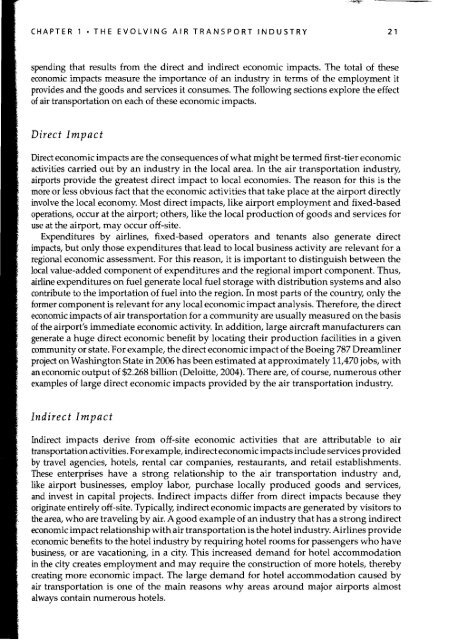The Evolving Air Transport Industry
The Evolving Air Transport Industry
The Evolving Air Transport Industry
- TAGS
- evolving
- komaristaya.ru
Create successful ePaper yourself
Turn your PDF publications into a flip-book with our unique Google optimized e-Paper software.
CHAPTER 1· THE EVOLVING AIR TRANSPORT INDUSTRY<br />
spending that results from the direct and indirect economic impacts. <strong>The</strong> total of these<br />
economic impacts measure the importance of an industry in terms of the employment it<br />
provides and the goods and services it consumes. <strong>The</strong> following sections explore the effect<br />
of air transportation on each of these economic impacts.<br />
Direct Impact<br />
Direct economic impacts are the consequences of what might be termed first-tier economic<br />
activities carried out by an industry in the local area. In the air transportation industry,<br />
airports provide the greatest direct impact to local economies. <strong>The</strong> reason for this is the<br />
more or less obvious fact that the economic activities that take place at the airport directly<br />
involve the local economy. Most direct impacts, like airport employment and fixed-based<br />
operations, occur at the airport; others, like the local production of goods and services for<br />
use at the airport, may occur off-site.<br />
Expenditures by airlines, fixed-based operators and tenants also generate direct<br />
impacts, but only those expenditures thatlead to local business activity are relevant for a<br />
regional economic assessment. For this reason, it is important to distinguish between the<br />
local value-added component of expenditures and the regional import component. Thus,<br />
airline expenditures on fuel generate local fuel storage with distribution systems and also<br />
contribute to the importation of fuel into the region. In most parts of the country, only the<br />
former component is relevant for any local economic impact analysis. <strong>The</strong>refore, the direct<br />
economic impacts of air transportation for a community are usually measured on the basis<br />
of the airport's immediate economic activity. In addition, large aircraft manufacturers can<br />
generate a huge direct economic benefit by locating their production facilities in a given<br />
community or state. For example, the direct economic impact of the Boeing 787 Dreamliner<br />
project on Washington State in 2006 has been estimated at approximately 11,470 jobs, with<br />
an economic output of $2.268 billion (Deloitte, 2004). <strong>The</strong>re are, of course, numerous other<br />
examples of large direct economic impacts provided by the air transportation industry.<br />
Indirect Impact<br />
Indirect impacts derive from off-site economic activities that are attributable to air<br />
transportation activities. For example, indirect economic impacts include services provided<br />
by travel agencies, hotels, rental car companies, restaurants, and retail establishments.<br />
<strong>The</strong>se enterprises have a strong relationship to the air transportation industry and,<br />
like airport businesses, employ labor, purchase locally produced goods and services,<br />
and invest in capital projects. Indirect impacts differ from direct impacts because they<br />
originate entirely off-site. Typically, indirect economic impacts are generated by visitors to<br />
the area, who are traveling by air. A good example of an industry that has a strong indirect<br />
economic impact relationship withair transportation is the hotel industry. <strong>Air</strong>lines provide<br />
economic benefits to the hotel industry by requiring hotel rooms for passengers who have<br />
business, or are vacationing, in a city. This increased demand for hotel accommodation<br />
in the city creates employment and may require the construction of more hotels, thereby<br />
creating more economic impact. <strong>The</strong> large demand for hotel accommodation caused by<br />
air transportation is one of the main reasons why areas around major airports almost<br />
always contain numerous hotels.<br />
21


